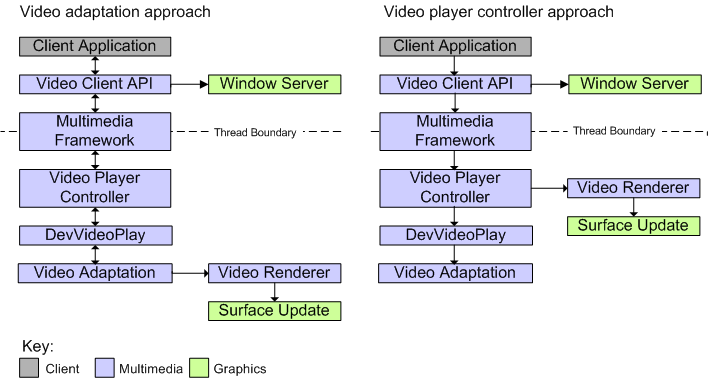Video Renderer Overview
This topic describes the Video Renderer component and is aimed at video controller and video adaptation developers who want to take advantage of rendering to graphics surfaces.
Purpose
The Video Renderer renders video to a graphics surface. The Video Renderer can be used by video decoders, video post-processors and video controllers. It can also be used to implement the ECam viewfinder using a graphics surface.
The Video Renderer has two modes: timed and non-timed. In timed mode, the Video Renderer renders a frame at a specific time. In non-timed mode, the Video Renderer renders a frame immediately.
On the Symbian platform, ScreenPlay (also known as the New Graphics Architecture or NGA) enables rendering to a graphics surface. The Video Renderer can only be used in conjunction with ScreenPlay. The Video Renderer does not contain any video or graphics processing software. All operations that are needed to display video content on the screen are handled by the Graphics Composition Components.
The Video Renderer component is classified as Optional Replaceable. This means that device creators can either substitute it with their own implementation or remove it if they do not want to use it.
Required background
To understand the Video Renderer, the reader must be familiar with the following:
Architecture
The Video Renderer can be implemented in two different ways, as shown in the following diagram:
Note: For simplicity, only the Multimedia Framework client/controller thread boundary has been shown; other thread boundaries may exist.
In both architectures, the Video Client API (CVideoPlayerUtility2) is responsible for retrieving graphics surface handles from the video player controller and registering them with the Window Server. The difference in the two approaches is in the implementation of the video adaptation and the video player controller:
Video adaptation approach
The video adaptation uses the Video Renderer to create and manage graphics surfaces and handle video rendering. The video player controller simply passes surface information between DevVideoPlay and the client. An example of this is the Symbian reference AVI player controller and XVid decoder. Symbian recommends this approach for new implementations.
Video player controller approach
The video player controller uses the Video Renderer to create and manage graphics surfaces, and handle video rendering and timing. This approach is suitable for implementations where DevVideoPlay is only used as a codec interface or where DevVideoPlay is not used.
In both architectures, the Surface Update component provides a communication channel between the Video Renderer and the composition engine.
APIs
The Video Renderer component contains the following DLL with its associated APIs:
| DLL | Description |
|---|---|
videorenderer.dll |
The functionality of the Video Renderer is provided by the following key classes:
The Video Renderer also uses a resource file (videorenderer.rss) to store supported pixel formats and timed mode values. For more information, see Video Renderer Resource File. |
Copyright ©2010 Nokia Corporation and/or its subsidiary(-ies).
All rights
reserved. Unless otherwise stated, these materials are provided under the terms of the Eclipse Public License
v1.0.
